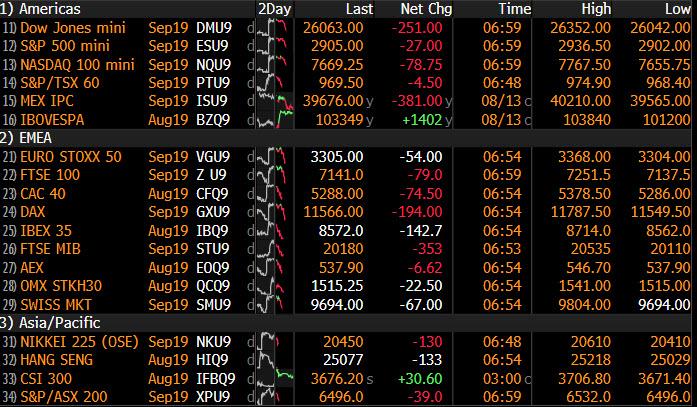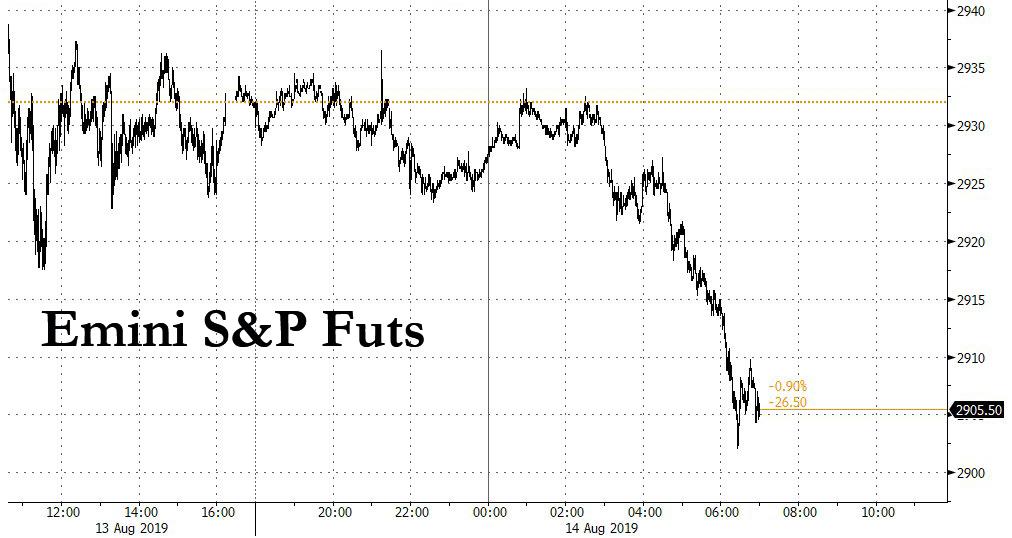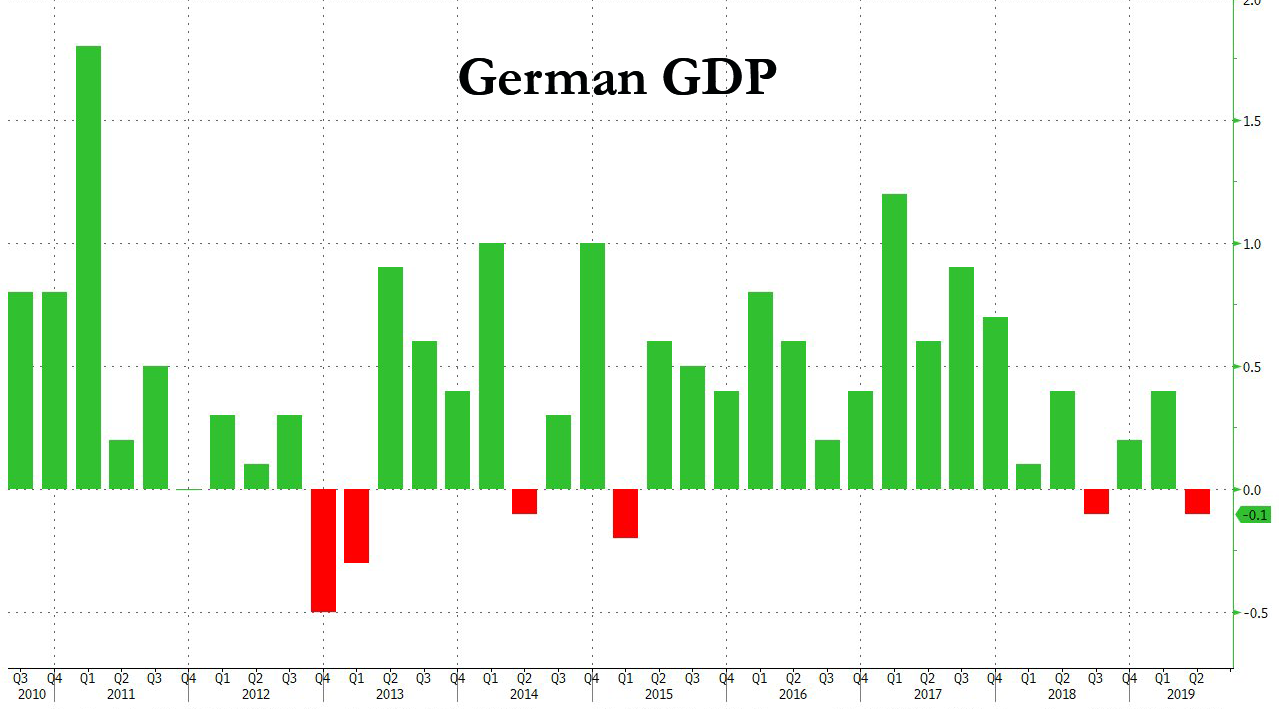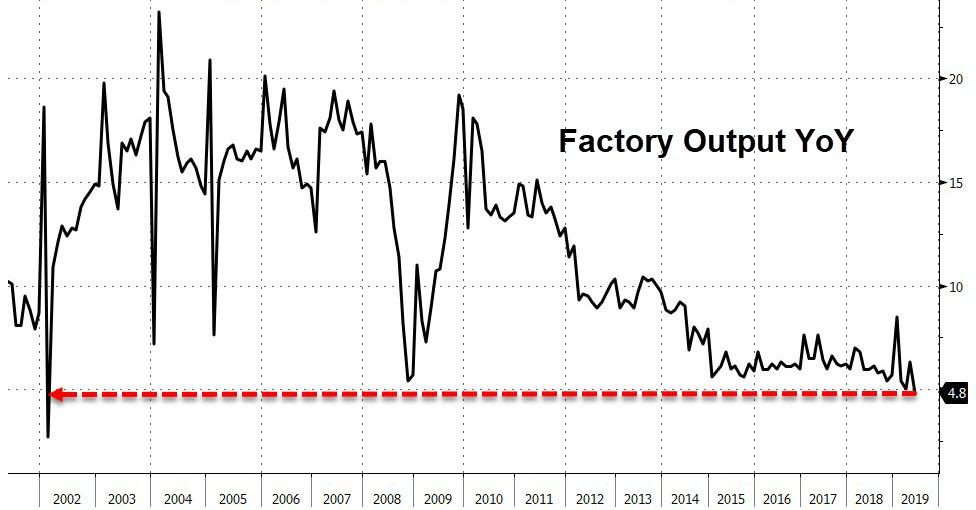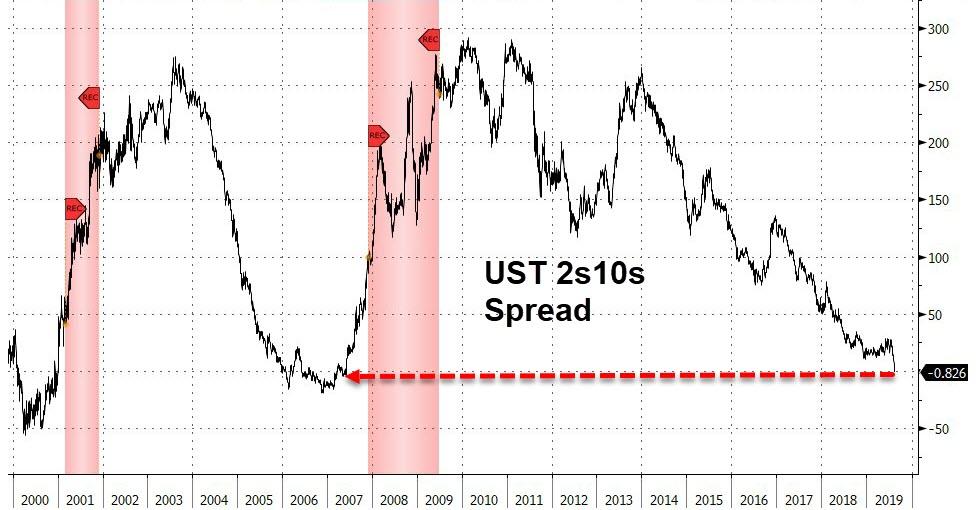Uddrag fra Zerohedge:
For the third day in a row, global markets started off the session with some bullish enthusiasm – this time on hopes of a trade deal with China following Trump’s delay to some key tariffs – only to see it all fade, as global stocks were flushed down the red drain thanks to dismal economic news first from China, whose key economic indicators all missed overnight and factory output tumbled to a 17 year low, then from Germany where GDP contracted for the 2nd time in 4 quarters sending the country to the verge of recession, and culminating with the inversion of both the UK and US 2s10s yield curve as the 30Y Treasury yield dropped to a record low, sliding below the effective fed funds rate for the first time ever.
US equity futures slumped to session lows, dropping alongside European stocks as weak data from two of the world’s biggest economies overshadowed an apparent de-escalation in the trade war. Treasuries and European bonds rallied, with key parts of both the U.S. and U.K. yield curves inverting.
European stocks fell on poor industrial production data and as Germany’s economy went into reverse, reviving fears of global recession and tempering a rally for equities after Washington delayed tariffs on some Chinese imports. Germany shrank 0.1% in the second quarter as the trade war and weak demand dragged on German manufacturers. The euro zone as a whole reported gross domestic product grew just 0.2% in the same quarter.
The Euro Stoxx 600 fell 0.4%, with markets in London, Frankfurt and Paris losing from 0.2% to 0.6%, tracking U.S. futures lower, as all but two of the 19 industry groups decline. Carmakers, banks and miners are the worst performers, while food-and-beverage shares temper the benchmark’s decline. Cyclical shares are retracing some of Tuesday’s gains after data from China and Germany flag a worsening economic outlook.
Earlier in the session, Asian stocks advanced, led by technology firms, as easing trade tensions between the U.S. and China spurred a relief rally around the world. Almost all markets in the region were up, with India and Japan leading gains. The Topix climbed 0.9%, supported by electronic and telecommunication firms, as Japanese traders looked beyond the worst earnings in three years and bet on a turnaround. The Shanghai Composite Index added 0.4%, with Kweichow Moutai advancing to a new record, even though China’s economy slowed more than expected in July, posting the weakest industrial output growth since 2002. The 4.8% growth was the lowest in 17 years.
The German figures, along with data showing the slowest growth for Chinese industrial output in 17 years stoking recession worries, knocked the wind out the sails for stocks.
Sure enough, this quickly manifested itself in the bond market, with the U.K. yield curve inverting for the first time since the financial crisis and the pound strengthened after inflation unexpectedly rose above the Bank of England’s 2% target in July. The US Treasury yield curve also inverted as the spread between US two-year and 10-year Treasury yields – a closely watched metric for signs of a slowdown and a famous recession predictor – finally turned negative after 12 years.
“The bond market is saying central banks are behind the curve,” said Marc Ostwald, global strategist at ADM Investor Services in London. “It’s all doom and gloom on the global economy.”
Earlier in the session, investors had cheered earlier when U.S. President Donald Trump pushed back a Sept. 1 deadline for new tariffs on remaining Chinese imports. The S&P 500 which had fallen 1% on Monday, rose 1.5% on Tuesday, sending Asian stocks outside Japan up 0.6%. Benchmarks in Shanghai, Hong Kong and Tokyo all mirrored the surge in U.S. stocks. But the momentum ebbed in Europe, as optimism faded that Trump’s move meant tensions were easing and Germany’s slowdown showed the damage already done by the trade war.
“The trade war and the dispute between U.S. and China has already had an impact – especially when you look at countries most sensitive to global trade like Germany and even Italy,” said Christophe Barraud, chief economist and strategist at Market Securities in Paris.
Meanwhile, Hong Kong’s airport resumed normal operations after a chaotic night of protest in which demonstrators beat and detained two suspected infiltrators and Trump warned of Chinese troops massing on the border.
In FX, the safe haven Japanese yen gained 0.3% to 106.42 per dollar as the Chinese data signaled that any resolution to the trade war was a long way off. Mirroring that view, the offshore Chinese yuan fell 0.4% against the dollar to 7.0337, erasing gains made the day before and remaining weaker than the 7 to the dollar it reached last week. The Australian dollar fell after the China economic data, including retail sales and industrial output, missed estimates. Swedish inflation data comes in stronger than forecast yet the krona fails to sustain knee-jerk reaction gains. The pound gained after U.K. inflation unexpectedly accelerated above the Bank of England’s target.
The yuan rose after China’s central bank set the daily fixing at a level stronger than the market expected for a fifth straight day. The People’s Bank of China strengthened the fix to 7.0312 per dollar Wednesday, snapping a nine-day streak of weakening, after Donald Trump decided to delay the imposition of new tariffs on a wide variety of Chinese goods until December. The 10% tariff postponement on largely consumer products including toys and laptops came after U.S. and China senior trade officials spoke by phone. Trump said the conversation was “productive” and that the delay was made “so it won’t be relevant to the Christmas shopping season”.


